When Jim Connelley founded Automated Simulations in the late autumn of 1978 to publish his and Jon Freeman’s new game, Starfleet Orion, the personal computer game market was in its very infancy. In fact, it was so new that Automated Simulations is regarded not only as one of the earliest computer game companies but also as the first publisher to solely focus on computer games. While companies like Apple, and Tandy Radio shack, among others, were publishing computer games, it was indeed not their sole focus.
In the late ’70s when the personal computer revolution took off, two major factors influenced the computer games to come. The fast-paced Coin up action games and the traditional tabletop games of the time. Gary Gygax and Dave Arneson’s 1974 roleplaying tabletop game Dungeons & Dragons had captured an entire generation, for better or worse, and become a cultural phenomenon. The game’s fantasy and role-playing elements very much defined the computer roleplaying game genre and what it would develop into in the decades to come. Besides the direct influence on mechanics and rules, games like Dungeons & Dragons would also spawn a new generation of programmers and developers who wanted to make use of the computer to aid with the tedious Dungen Master bookkeeping a typical game would require.
In 1977 Jon Freeman was introduced to Jim Connelley when Freeman was invited, by a mutual friend, to a game of Dungeons & Dragons hosted by Connelley.
To help and automate with some of the dungeon master bookkeeping, Connelley, in 1978, bought a Commodore PET 2001. The 1 MHz computer was definitely not a cheap device, costing around $3500 in today’s money. Connelley wanted not only to write off the computer on his taxes but was also looking for ways to get some of his hard-earned money back on the machine. His best bet was to develop a game and hopefully be able to sell it. While Connelley loved traditional games and had been a professional developer for years, working as a programmer for a division of Westinghouse, he still needed a hand with gameplay elements and rules. Enter Freeman who not only was a seasoned tabletop game player but also a frequent contributor of articles to GAMES magazine.
Starting out in the summer of 1978, Freeman would draw from his many years of experience with board games and write the basic rules set, define the missions and background stories, all while Connelley coded up everything in Commodore BASIC on his PET.
In November of 1978 when Freeman and Connelley’s two-player sci-fi game, Starfleet Orion was about to be complete. Connelley founded Automated Simulations to market and publish the game and granted shares in the company to Freeman.
The Automated Simulations name was primarily derived from another company, Simulations Publications, Inc., which was an up-and-coming competitor to Avalon Hill in the tabletop wargame arena.
While Freeman and Connelley’s original thought was to focus only on the simulation genre it became clear later on that the action and roleplaying genre not only would cater to a much bigger audience but also would be much more in line with their love for pen and paper Dungeons & Dragons. The company had to come up with a subbrand for upcoming titles that weren’t simulations per se, but more on this later.
Starfleet Orion
In December of 1978, Starfleet Orion, the very first microcomputer Sci-fi strategy game, was released for the TRS-80 and a tad later for the Commodore PET.
Starfleet Orion was a two-player only turn-based sci-fi strategy game, playing out battles between fleets on a 32×64 grid. On one side The Stellar Union on the other The Confederation of Orion. The game included 12 increasingly complex scenarios and 22 different ship types. Each player would enter their text commands one after another, and at the end of a round, the turns were executed simultaneously. A scenario would end when all ships on one side were destroyed or had escaped the playfield.
Connelley and Freeman had no background in computer game publishing, but in 1978 only a few people did. The duo hired a local printer and typesetter to print a number of manuals, bought a bunch of plastic bags, and duplicated the cassettes by hand. For the first six months, the whole production and distribution process was run out of the spare bedroom in Connelley’s apartment.
While Starfleet Orion was originally programmed in BASIC for the Commodore PET, the duo decided to release a TRS-80 version of the game first. The TRS-80 home computer not only appealed much more to gamers by being more home-oriented, it also had a much larger install base than the PET. The game was also ported to the Apple II – All different BASIC versions irrelevant to computer architecture were quite similar which meant easy and quick conversions.
The Commodore PET and TRS-80 versions were similar and released on cassette which required the player to punch in the scenario data from the included Battle Manual and then save it to a separate cassette before playing, a slow and tedious process.
This was greatly improved on the Apple II floppy disk version released in 1979. The floppy disk version had the space to encompass all the scenarios without having the user typing in strings of text. Players were also able to create their own scenarios using the separate builder program and saving them to cassettes or floppies.
The Apple II version, as the only, featured a very simple graphic representation of the ships instead of just dots. Otherwise, the version used text symbols, like an asterisk for explosions, just like with the Pet and TRS-80 version.
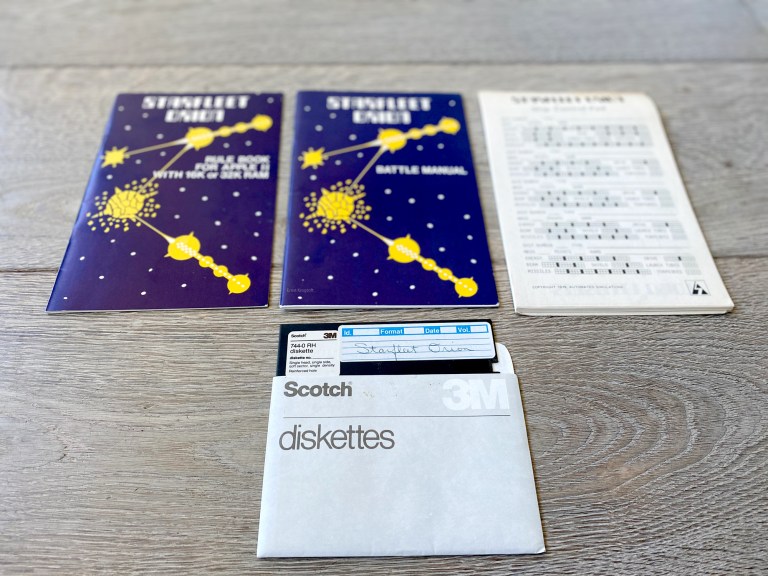
Automated Simulations’ very first title, Starfleet Orion. Here’s the Apple II version from 1979. Unfortunately only with a backup floppy
Invasion Orion
Automated Simulation’s next game, Invasion Orion, was a sequel to Starfleet Orion but unlike Starfleet Orion, the sequel was launched as a single-player game, playing against a computer opponent. Starfleet Orion’s Achilles heel had always been that it required two players to play. While one player was making his moves the other player had to turn around or leave the room.
When it was re-released for the Atari 8-bit in 1981, under the Epyx brand name, it featured a two-player mode as well.
Invasion Orion was from the getgo written for both the PET and TRS-80, and a bit later for the Apple II, to reach the broadest set of potential customers. All three versions were released in 1979.
On the left the original TRS-80 version of Invasion Orion from 1979. The TRS-80 version was developed and published at the same time as the Commodore PET version. Apple II users could get their hands on their version a bit later in 1979.
On the right the 1981 re-release for the Atari 8-bit
While the game mechanics remained the same as in Starfleet Orion
the sequel featured bigger scenarios and 8 more ships. With the included editor, you were not only able to create new scenarios but also to design new ships.
Starfleet Orion and Invasion Orion ended up as the only two titles in the saga of the Stellar Union and the Orion Confederation. A third title, Star Trader Orion was announced in an Automated Simulations promotional catalog in late 1979 (the only place the title was ever mentioned) with a release date in August of 1980 but this never materialized.
Temple of Apshai
While working on Invasion Orion, Connelley and Freeman visited a Dungeons & Dragons convention, in the hope that the traditional board gamers would fancy their sci-fi computer simulations, it became clear that what they really were really after was a computerized dungeon crawler.
When Invasion Orion was released, the duo started out on a fantasy roleplaying game inspired by the Dungeons & Dragons sessions that initially brought Freeman and Connelley together, they were also joined by Jeff Johnson, who had been attending their Dungeons & Dragons sessions, to help with both level and enemy character design.
Freeman would work out a role-playing rule system that would be integrated together with Connelley’s new BASIC engine. The system was very much inspired by the rules from Dungeon & Dragons and also allowed for importing pen and paper characters.
The first game utilizing the new engine and ruleset was Temple of Apshai, developed initially for the TRS-80 and released in 1979. The PET version was released the same year and the Apple II version, done by a third party, in 1980.
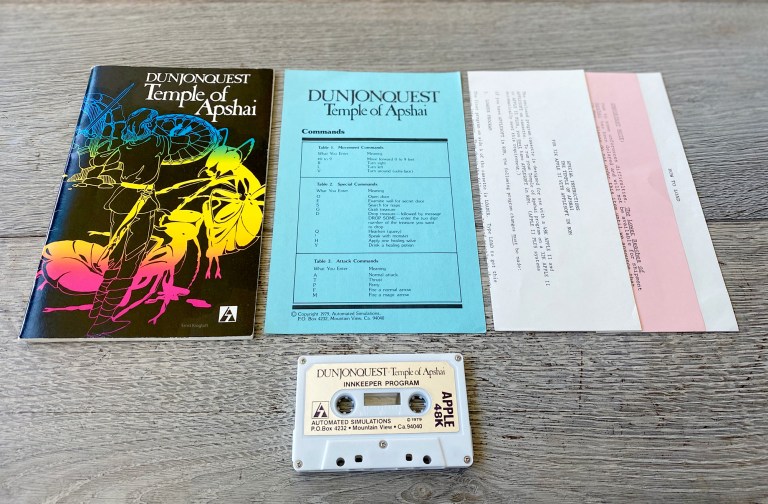
The original 1979 Apple II version, released on cassette.
One side had the Innkeeper program where you could generate characters with strengths and weaknesses and also purchase weapons and armor. The other side had the game, the Dungeonmaster program.
The cassette version did not have a save feature and thus you had to write down all statistics before quitting. Loading a game meant manually punching in the information again. Later floppy versions fixed this by allowing you to save all the statistics to the disk
Temple of Apshai was like the earlier sci-fi titles written in BASIC, was without sound and only very rudimentary graphics. It was later released for other 8-bit computers and the IBM/PC with sound and improved graphics.
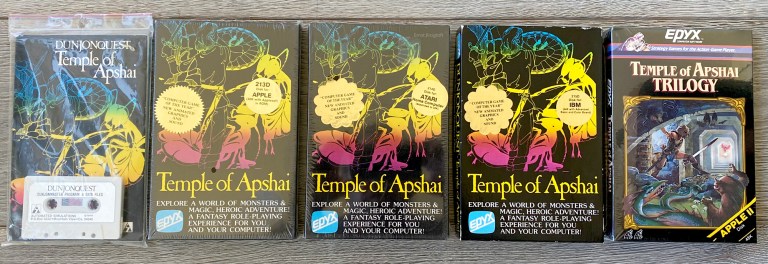
Different releases of Temple of Apshai and the later trilogy from 1985
The game spanned across four dungeons with increasing difficulty in the ruins of the temple of the ancient god Apshai. The dungeons combined had over 200 rooms and 30 different monstrous creatures.
The player would create a character using standard Dungeons & Dragons attributes, the mission to descent into the dungeons while uncovering treasures, finding weapons, hidden doors, battling enemies, and gaining experience. The game was without any end goal
The dungeon craw was turn-based, with the player and enemies taking turns performing actions.
While the graphics for the initial releases were simplistic, to say the least, consisting of just blocks and lines, the included 56-page manual, also referred to as the Book of Lore, described every room in the game, providing vital information and helped define the setting.
-Unlike the two earlier 1978 CRPG titles, Synergetic Software’s Dungeon Campaign and Don Worth’s Beneath Apple, Temple of Apshai didn’t utilize randomly generated dungeons.
Temple of Apshai was heavily advertised in traditional roleplaying game magazines, addressing the conventional players that might find the computerized roleplaying game interesting. But as it proved, the computer game market wasn’t picky at all and it wouldn’t take long before everybody with a personal computer wanted in on the action. Temple of Apshai became probably the most ported game of its day, released on every major personal computer of the time.
The Book of Lore described every single room in the game. While many crawlers would feature randomly generated dungeons, Temple of Apshai had “static” rooms which never changed. Every room in the game had a number which could be referred to in the book
Temple of Apshai spawned two expansions branded under the Dunjonquest label, Upper Reaches of Apshai and Curse of Ra. The three games ended up being so successful, or at least Temple of Apshai did, that they were later re-released in 1985 as the Temple of Apshai Trilogy with updated graphics, sound, and music. Westwood Studios was responsible for porting the trilogy to the 16-bits computers of the time.
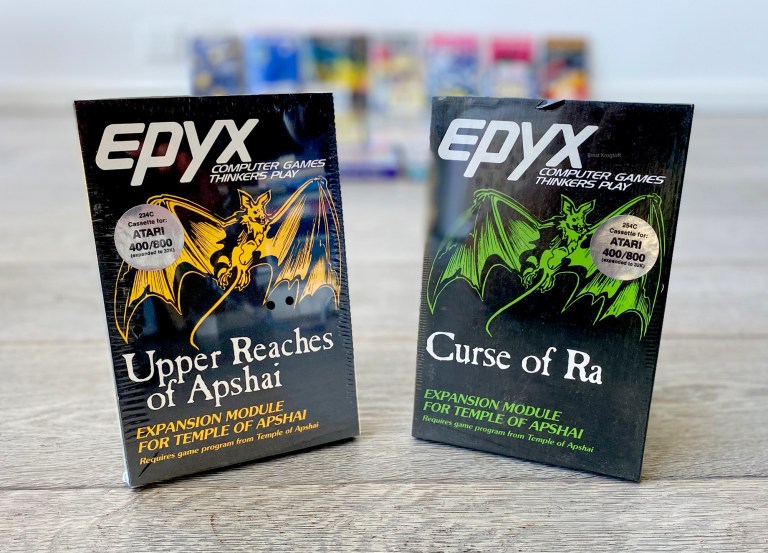
The two expansions for Temple of Apshai, both boosted four new dungeons each and required the original game since the expansions were nothing more than data files which had to be loaded through the original game. Upper Reaches of Apshai plays out in the innkeepers backward and had a more humorous tone. It was released in 1981. Curse of Ra, the third and quite more difficult expansion was set in ancient Egypt and released in 1982
Temple of Apshai went on to become a huge success and sold well over 30,000 copies by mid-1982. It was rated as the best computer game by nearly every magazine of the era.
Since Apshai was a roleplaying fantasy game, the Automated Simulations name didn’t quite fit it. Freeman and Connelley came up with the name Epyx, an alternative to Epic which was already in use by a record company, as a subbrand for the action and roleplaying games to come.
In the coming years, similar titles in the Dunjonquest line were published. These included the direct sequel Hellfire Warrior and its two expansion packs, The Keys of Acheron and Danger in Drindisti, all of which featured four dungeons.
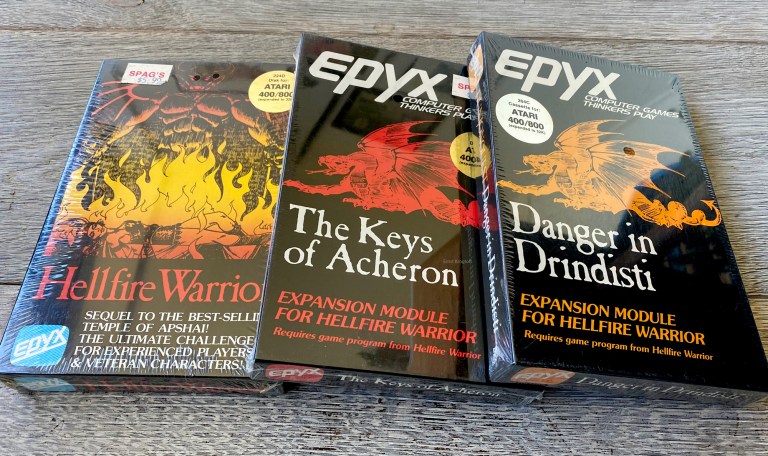
Hellfire Warrior, the only direct sequel to Temple of Apshai, released for the Atari 8-bit in 1980. Here depicted with its two expansion pack, The Keys of Acheron from 1981 and Danger in Drinsti from 1982
The more action-oriented Gateway to Apshai, a prequel to Temple of Apshai, released in 1983 was the last title in the Dunjonquest series.
MicroQuest
After the initial success with Temple of Apshai in 1979, Automated Simulations released the first game in its new MicroQuest series the same year with The Datestone of Ryn. The concept of the MicroQuest series was to address beginners and lesser experienced players who wanted a taste of roleplaying and dungeon crawling. The games in the series only featured one dungeon and no character-generator. The Datestone of Ryn had a 20-minute time limit for you to find all the Datestone and exit the dungeon.
The second title, Morloc’s Tower, was initially referred to as Dunjonquest #3 but was also placed in the MicroQuest series. The game was a bit more complex than the Datestones of Ryn but still simpler than Temple of Apshai. The game featured more notable adventure game elements than the other Dunjonquest titles.
The two titles ended up being the only ones in the series. Due to the smaller size, these were sold at half the price of its larger siblings.
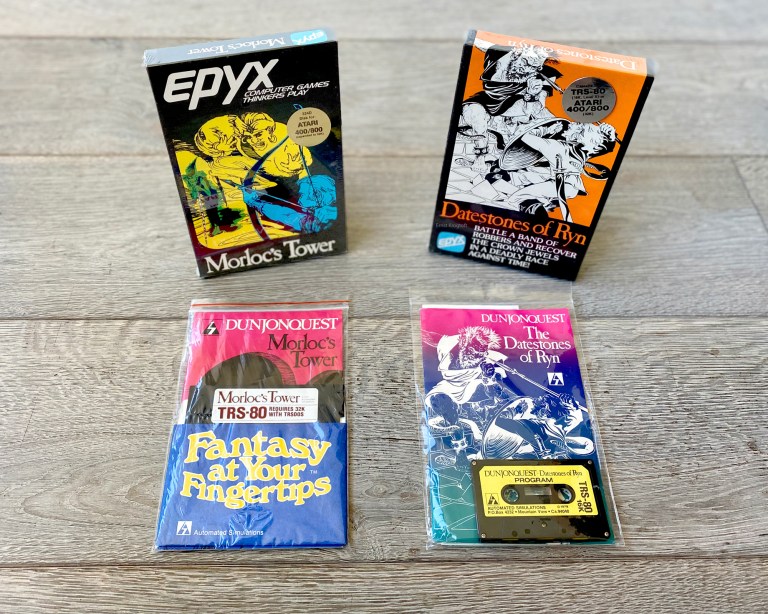
The only two titles in the MicroQuest series. Both created upon the initial success of Temple of Apshai. Both titles were originally released in plastic baggies in 1979 and later on in a boxed format.
On the left, the 1979 zip-lock release of Morloc’s Tower for the TRS-80 and the rerelease for the Atari 8-bit from 1981
On the right, the original 1979 Zip-lock release of The Datestone of Ryn for the TRS-80 and the rerelease for the TRS-80/Atari 8-Bit from 1981
A third title was being developed but ended up being too big to fit the MicroQuest label. The label was soon abandoned and the title, Sorcerer of Siva, ended up in size between the MicroQuest and the full-fledged Dunjonquest games. Sorcerer of Siva was released in 1981 as the last standalone Dunjonquest title and released for both the Apple II and TRS-80.
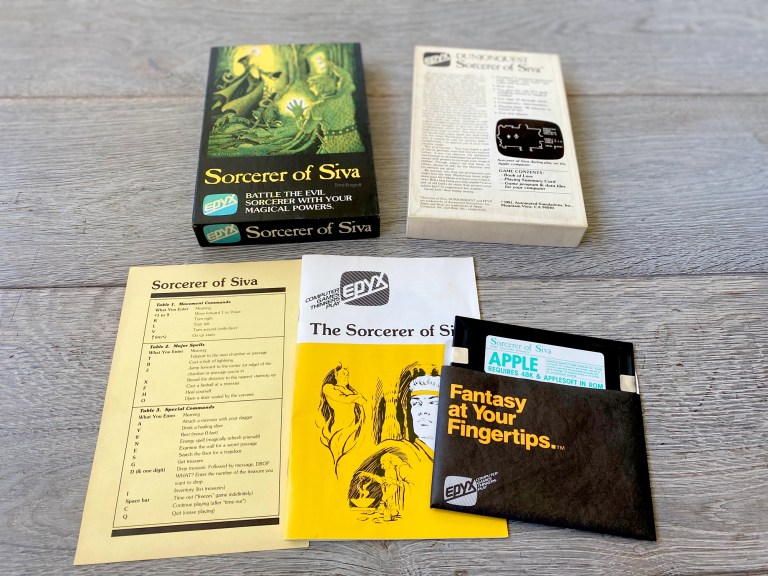
Sorcerer of Siva for the Apple II, released in 1981, the last standalone title in the Dunjonquest series
Starquest
Connelley’s BASIC engine was modified and used in the Starquest sci-fi series, which like the MicroQuest only ended up consisting of two games. The first title, Rescue at Rigel played out on a space station instead of a dungeon and with a story dedicated to a number of vintage science fiction heroes, including Buck Rogers, Lazarus Long, and the casts of Star Trek and Star Wars.
Star Warrior, the second title, was more strategy-oriented and was the first among the Dunjonquest and related titles to play out in an outdoor setting.
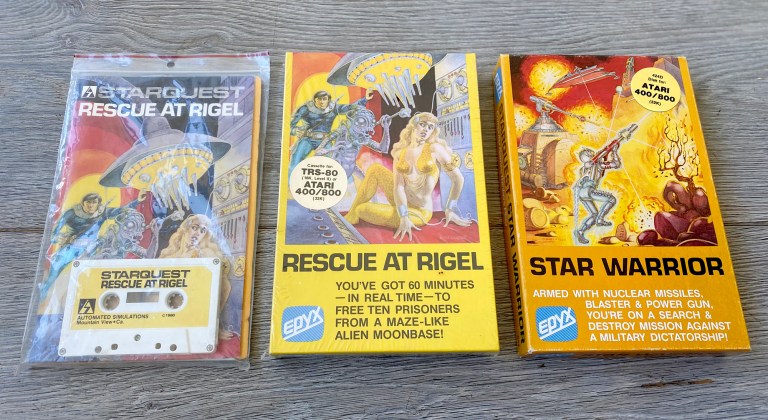
On the left the original baggie version of Rescue at Rigel from 1980, in the center the rerelease for the TRS-80/Atari 8-bit from 1980, on the right Starwarrior for Atari 8-bit from 1981 which only was released in a box
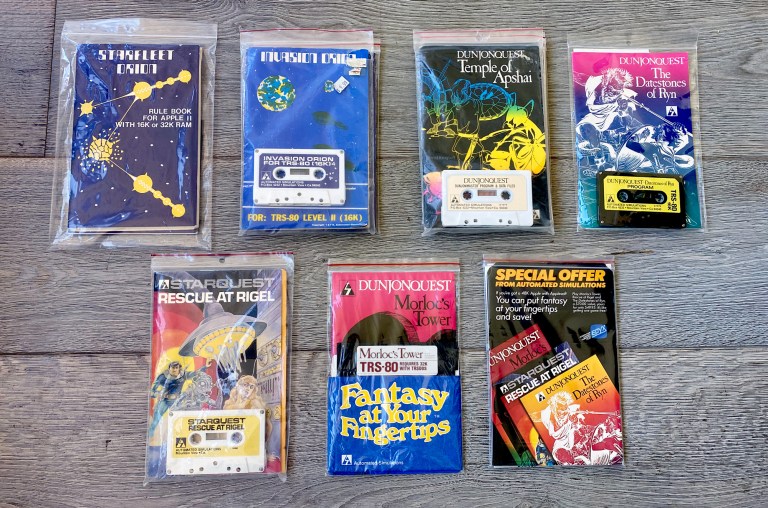
A small lineup of Automated Simulations zip-lock releases from 1978-1980. Most of the titles were later released for an array of personal computers and all in a boxed format
Mind Toys
In 1981 Automated simulations would release two titles in its newly created Mind Toys series. These would take a step away from fantasy and fast-paced action and focus on the mind. The two small but innovative titles in the series were Jabbertalky, a word game, and Ricochet, a trajectory-based cannonball game. None of the titles gained notable success and the brand was dissolved in 1983.
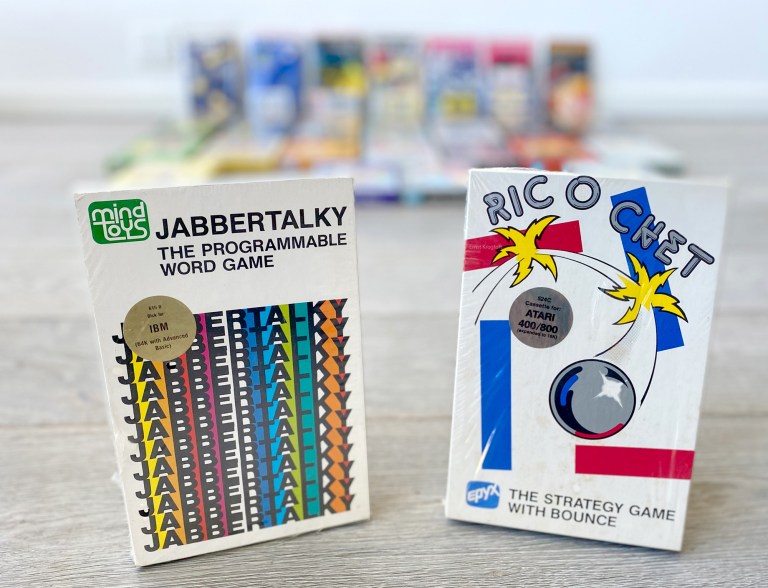
The two titles released in the Mind Toys series. Jabbertalky, here the IBM version from either late 1983 or early 1984 and Ricochet for Atari 8-bit released in 1981
The transition
While the Dunjonquest games and especially Temple of Apshai generated great success and fame they also spawned upcoming and fierce competition. Richard Garriot’s Ultima and Sir-Tech’s Wizardry roleplaying games were better in almost every way than what Connelley’s now already aging 1979 BASIC game-engine could deliver. Connelley was firm on continuing using his engine and while it was highly portable and capable of running on nearly any computer it was painfully slow and becoming more and more limited in what it could deliver on newer systems like the Atari 8-bit line of computers.
Freeman frustrated with Connelley not desiring to abandon his engine and commence developing a new modern and powerful one, one that could compete with the likes of Ultima and Wizardry, made him leave the company, together with his wife-to-be Anne Westfall in late 1981.
Freeman had met Westfall a year earlier at the 1980 West Coast Computer Faire and convinced her to join Automated Simulations, after a few months of dating. Westfall had earlier on worked as a programmer but she had never programmed games. At Automated Simulations, Westfall would start out by doing playtesting and later work on Sorcerer of Siva and Tuesday Morning Quarterback together with Freeman.
Freeman would together with Westfall and Paul Reiche III found Free Fall Associates, with a focus on writing games for the very capable Atari 8-bit computers. Freeman and Westfall would go on to create the two award-winning and highly acclaimed games Archon and Archon II for Electronic Arts.
Paul Reiche would, later on, co-create Star Control and Star Control II with Fred Ford, arguably some of the best space-themed games of the 20th century.
With Freeman gone and sales plummeting, investors were getting concerned, bringing in new key people to rework the company. Connelley was slowly but surely eased out of his own company and in 1983 he left with a number of employees to found The Connelley Group which would release a handful of games including his last title to be published by his old company, Dragonriders of Pern.
While Epyx was originally only meant as a brand name, the new name was shorter, more appealing, and less geeky-sounding – and with the new management reworking the company, Epyx naturally evolved into the company name. From 1980 to 1983 both names would appear on game boxes and content. By 1983 when the Epyx reconstruction was in full effect Freeman and Connelley’s Automated Simulations name was canned for good.
1983 was also the year where Epyx went more mainstream publishing Randy Glover’s hugely successful arcade game Jumpman. Topping sales charts for months on end and becoming one the bestselling Commodore 64 games of 1983. The game alone was enough to put Epyx back in the green.
The next many years Epyx saw great success with its action and sports games.
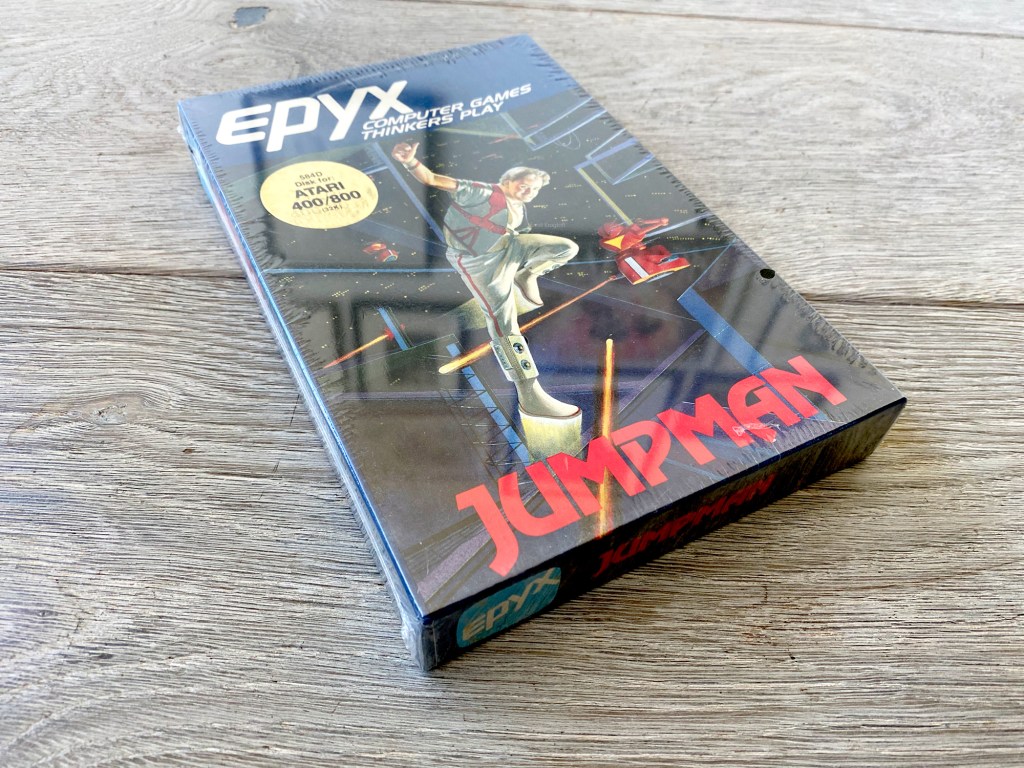
There seems to be a bit of confusion regarding Automated Simulations’ early titles. A lot of the printed material for the original plastic bag versions were reused or reprinted for the later boxed versions, meaning that the copyright year in the manual doesn’t match the actual release date, I’ve seen a few items where boxed content have been sold off or stated as original versions because of the year imprinted in the manual. The original baggies were sold in 1978, 1979 with a couple in 1980, and all have only the Automated Simulations name associated with it. The year on the cassettes or floppies should match the manual, and all is either for the PET, TRS-80, or Apple II. Most of these releases have an instruction inlay which should have a year and/or a date to match the media.
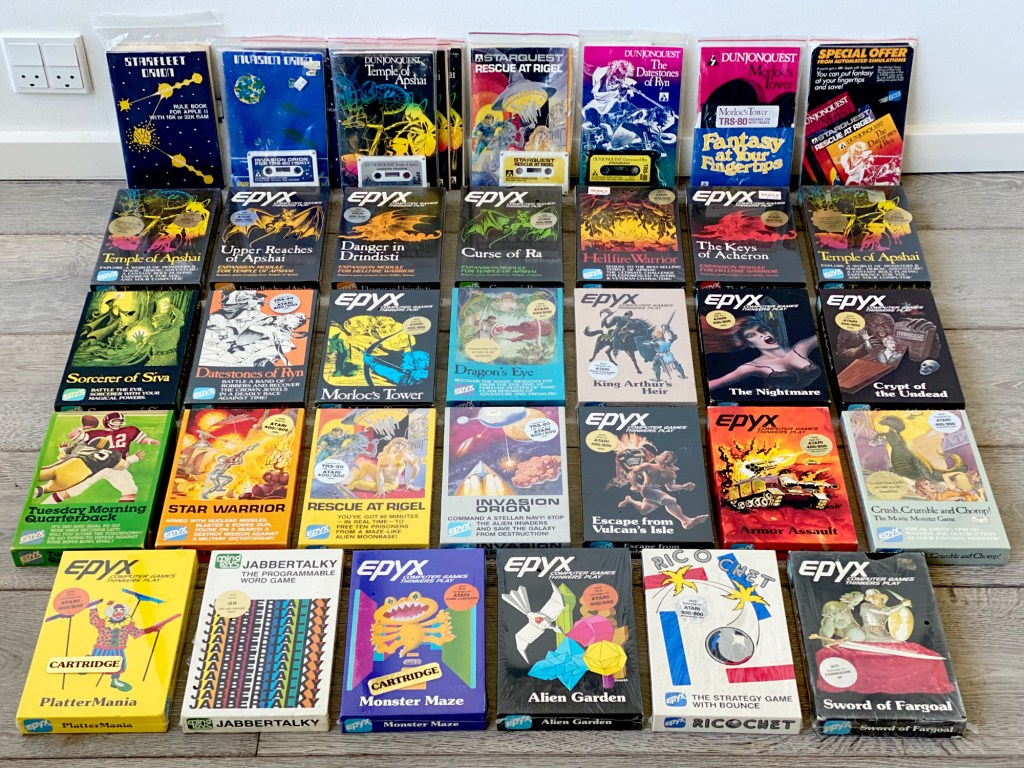

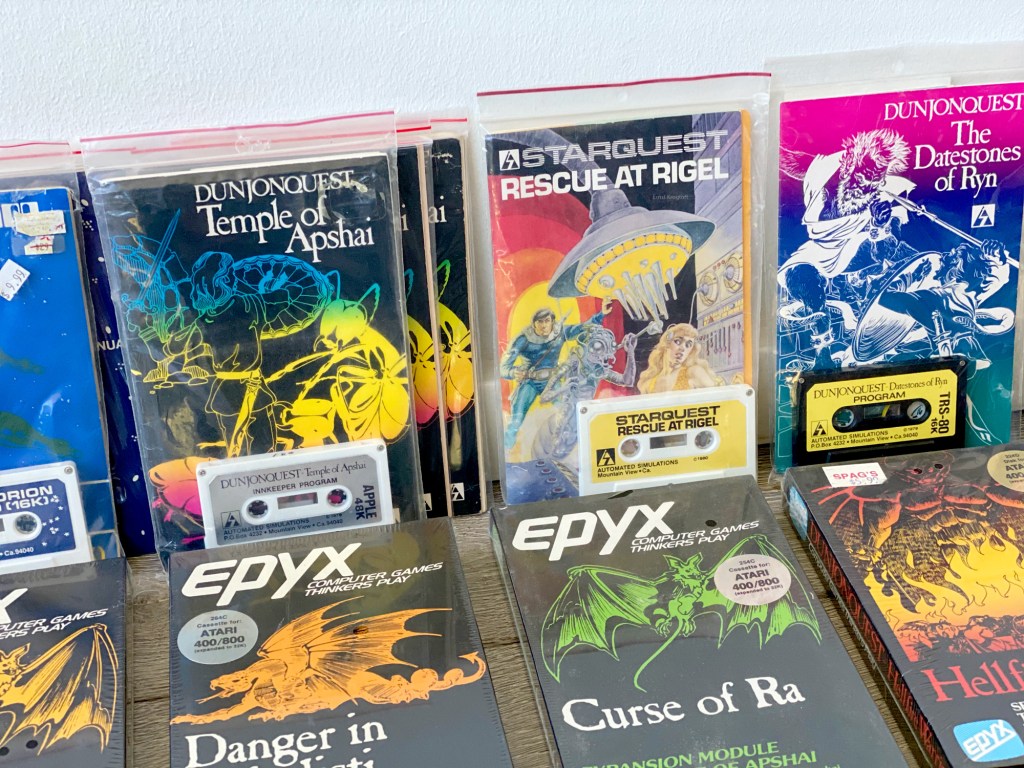
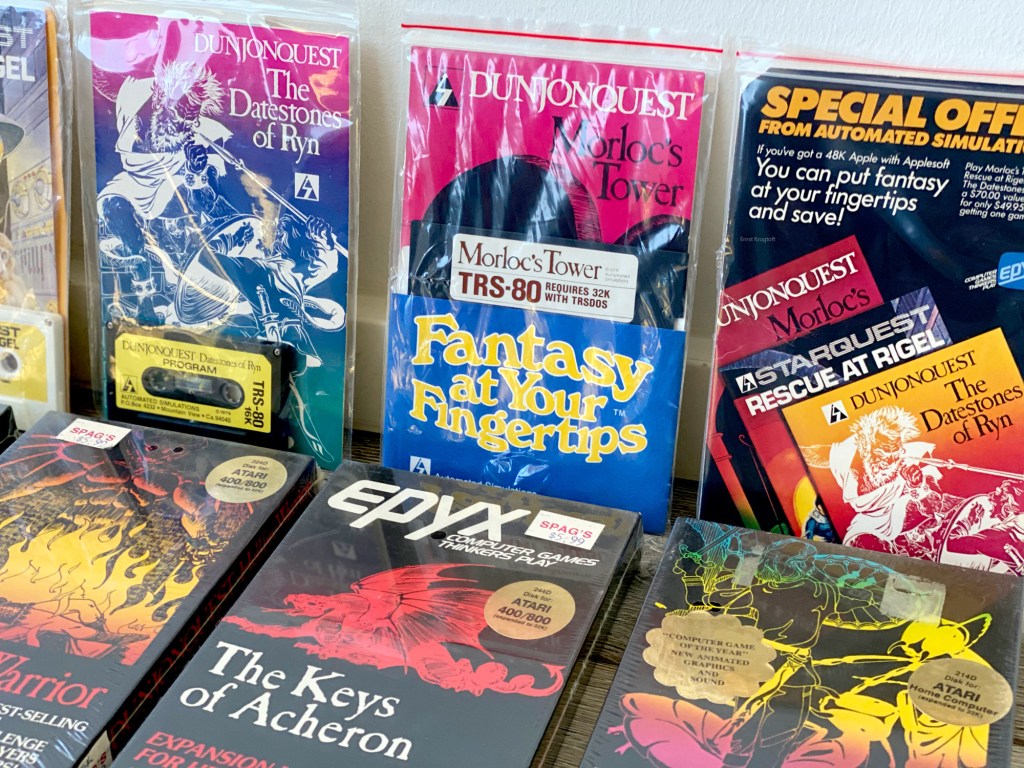
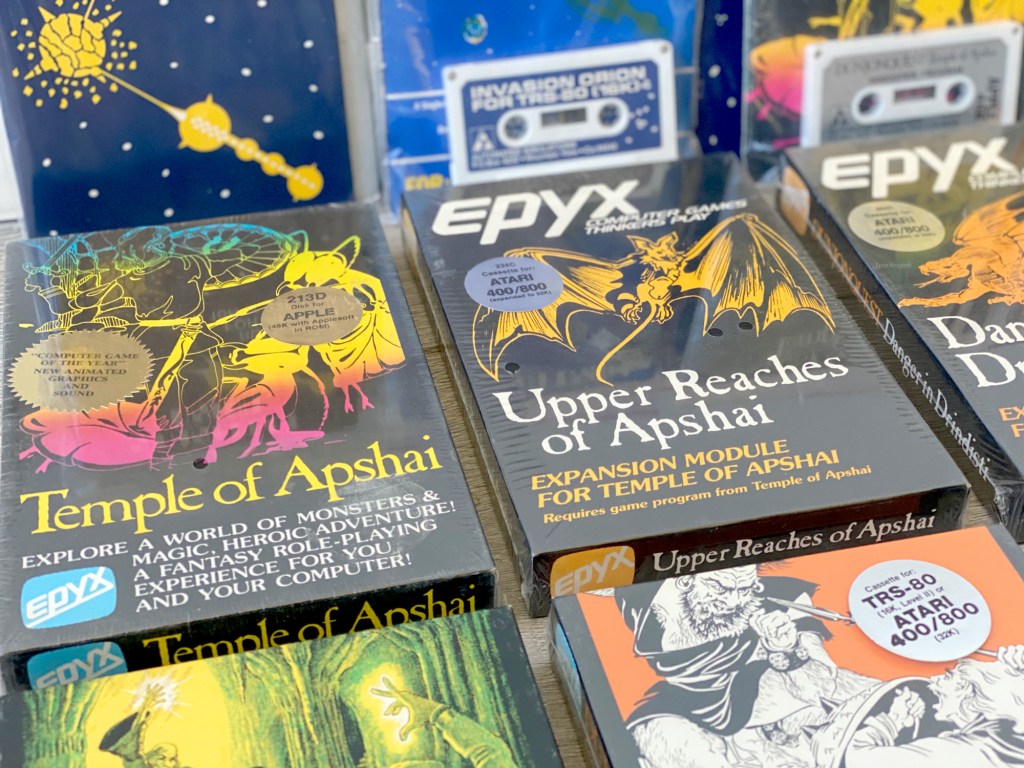

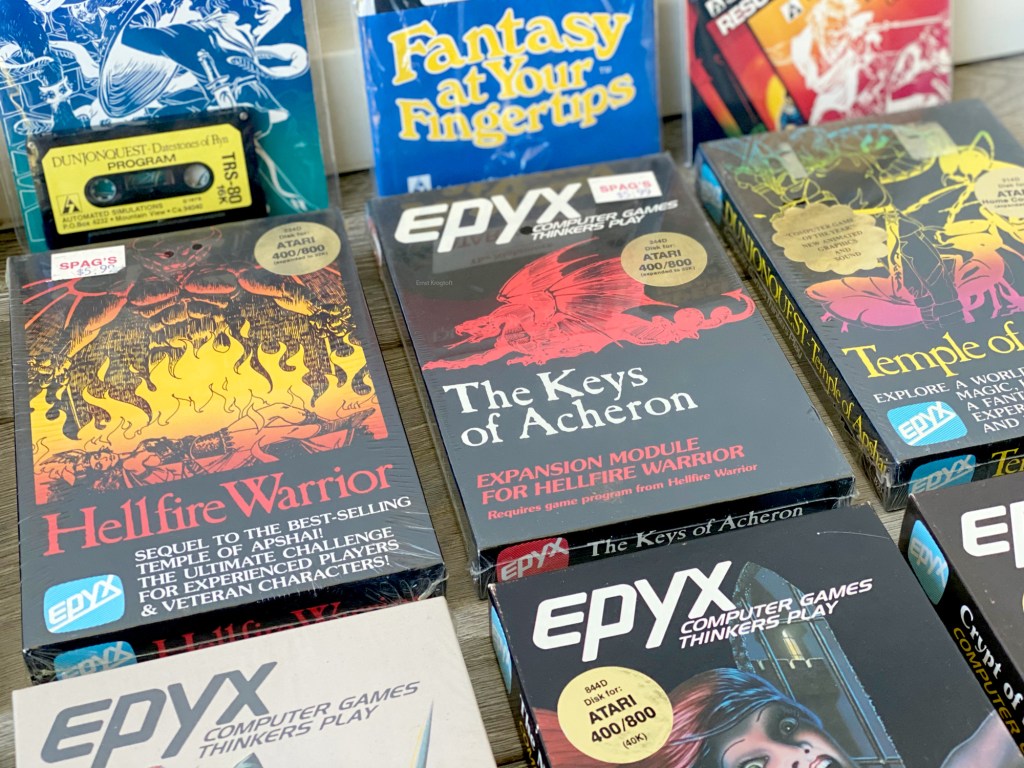
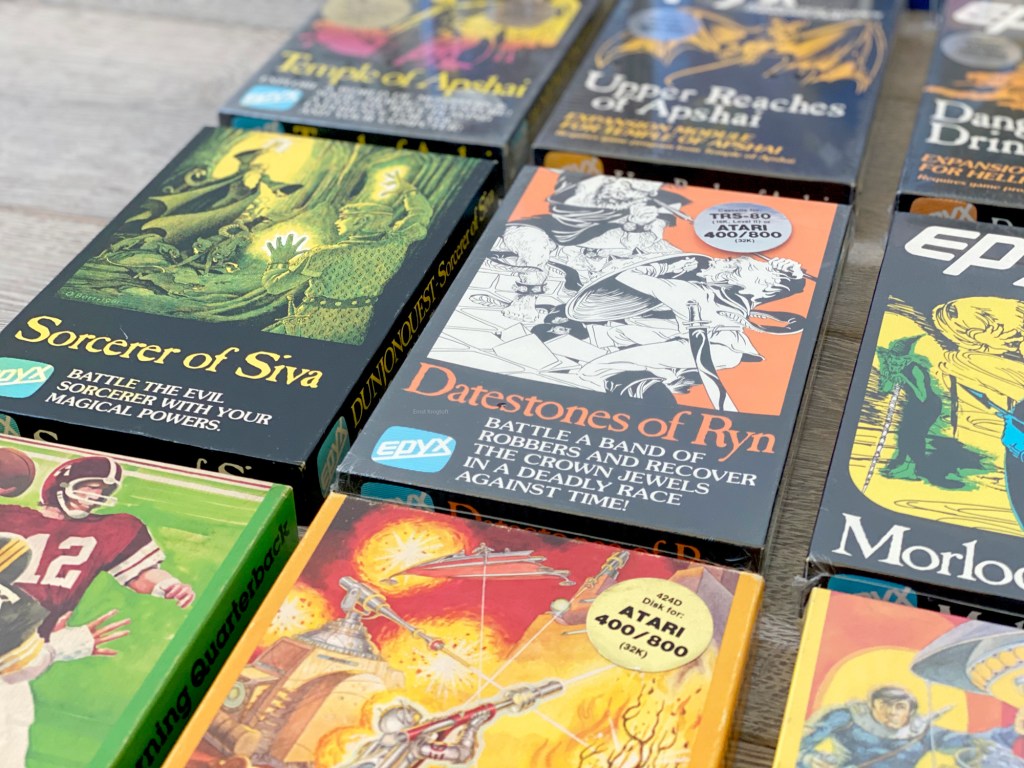
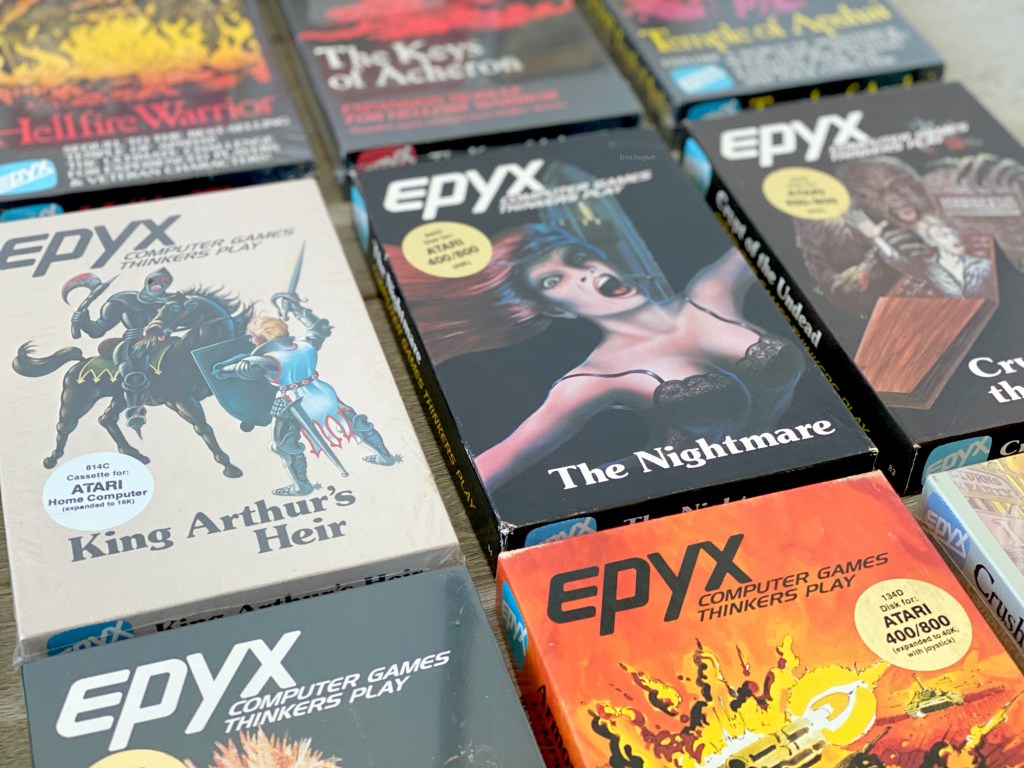
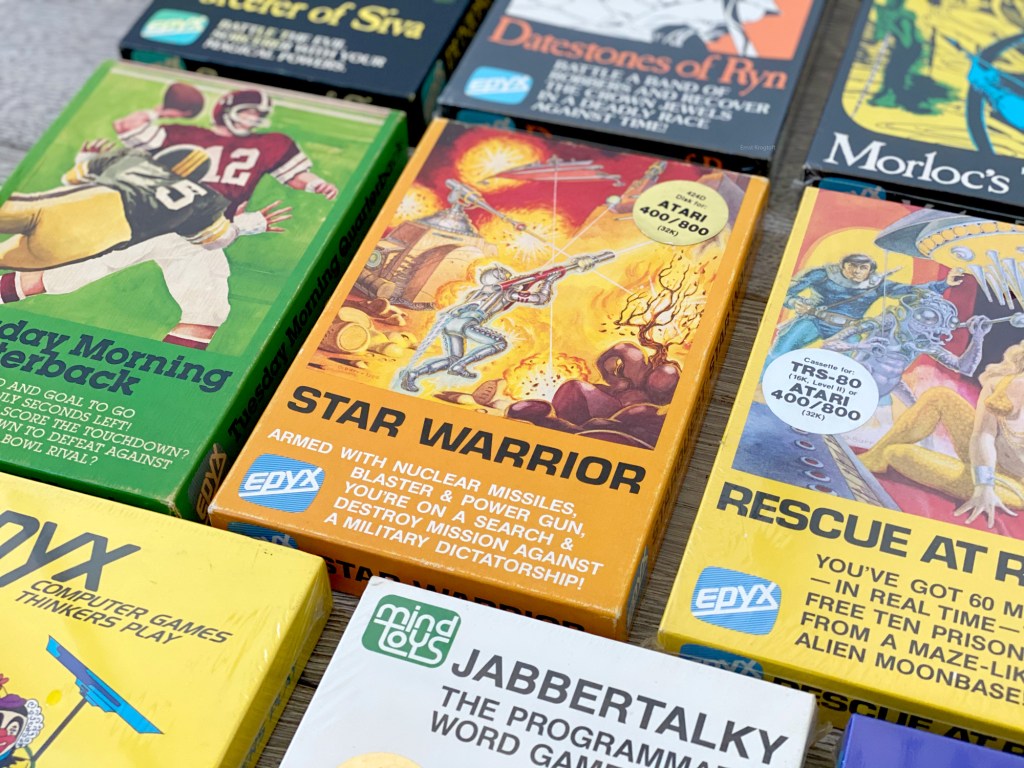
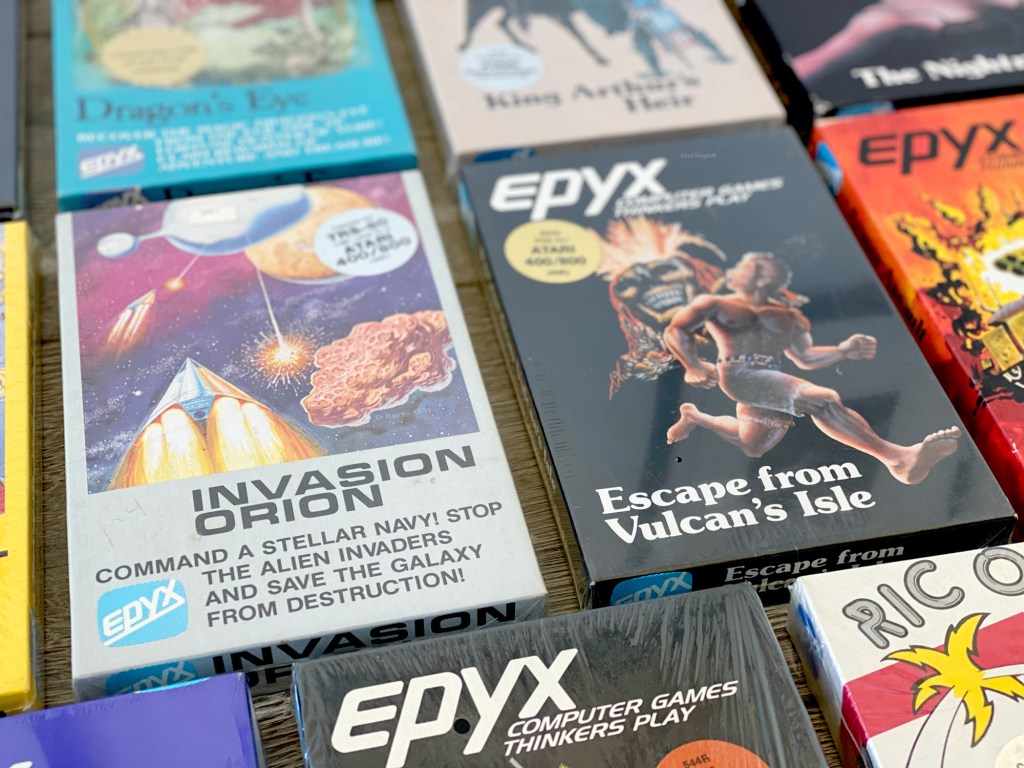
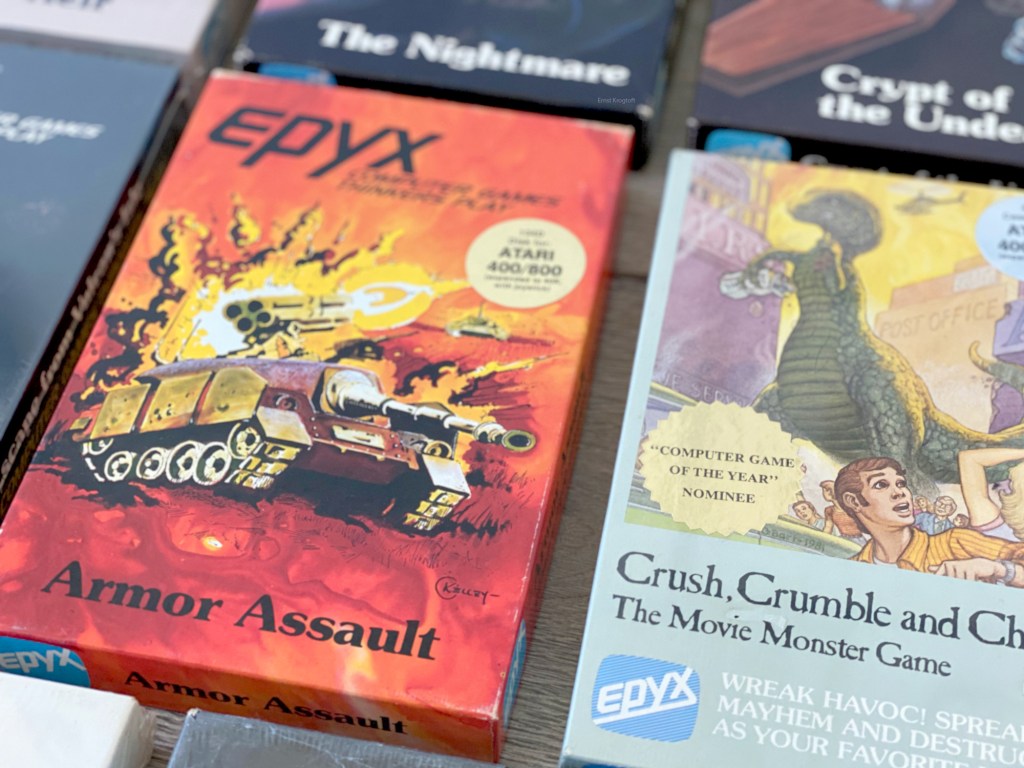
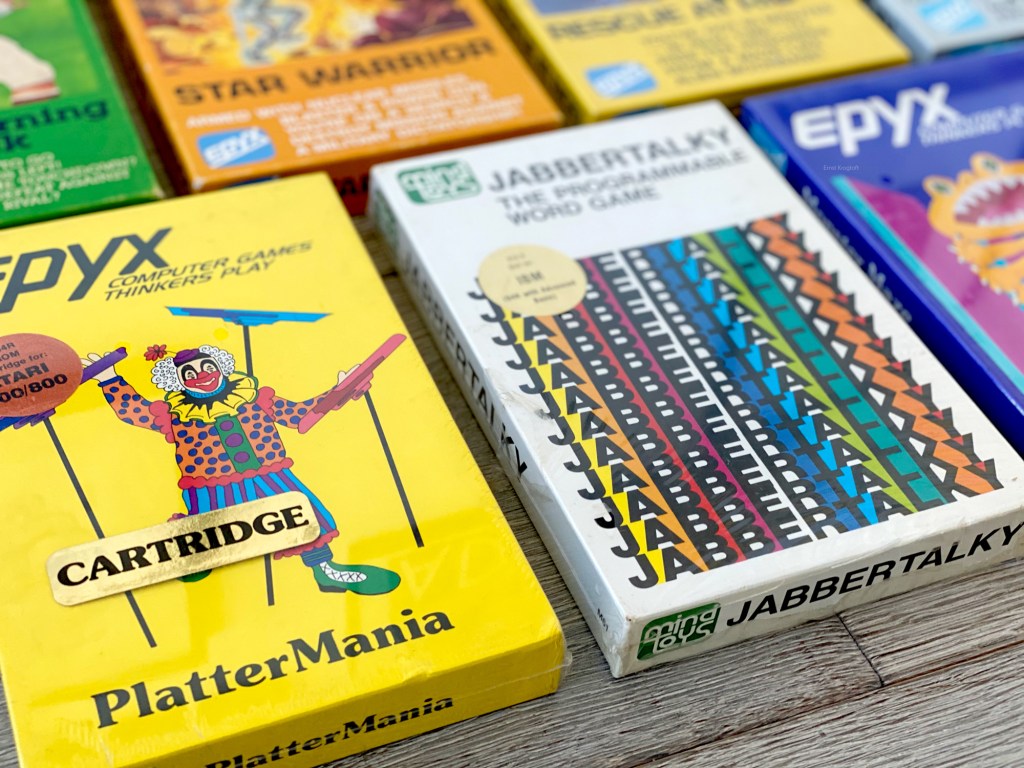
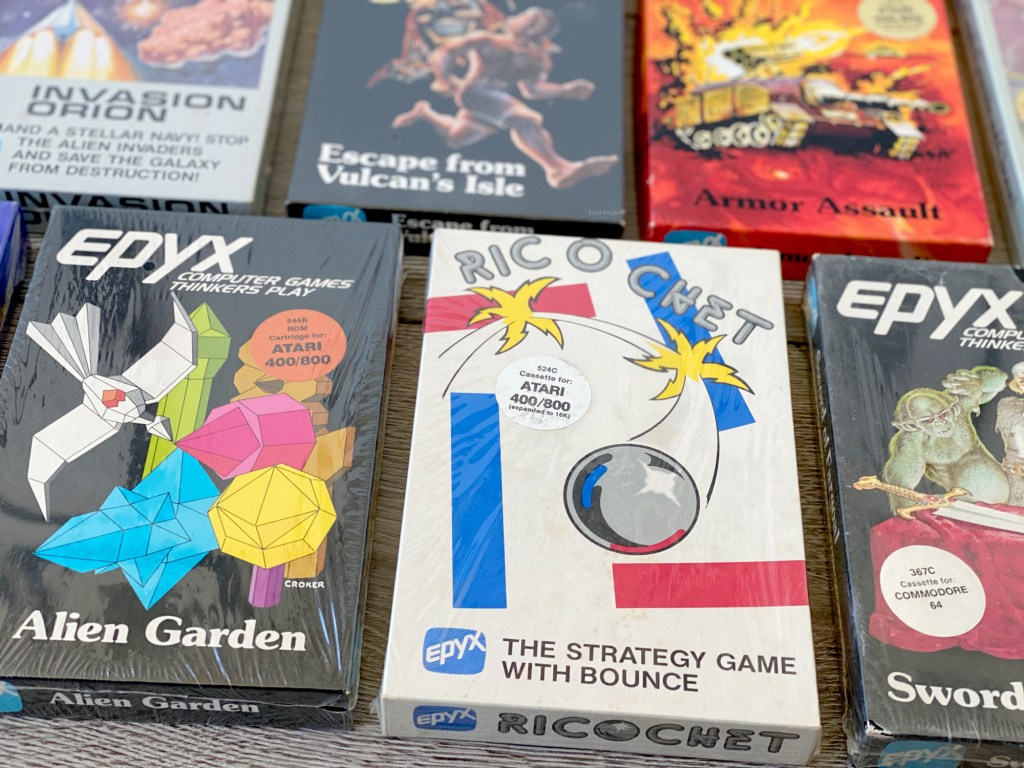
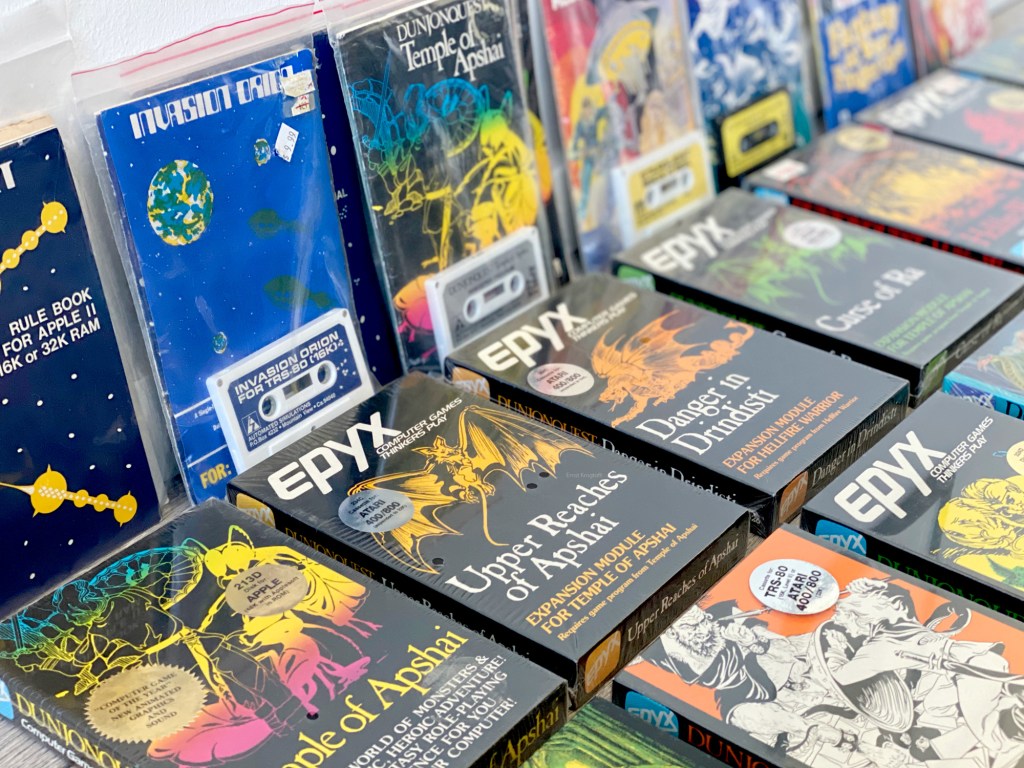
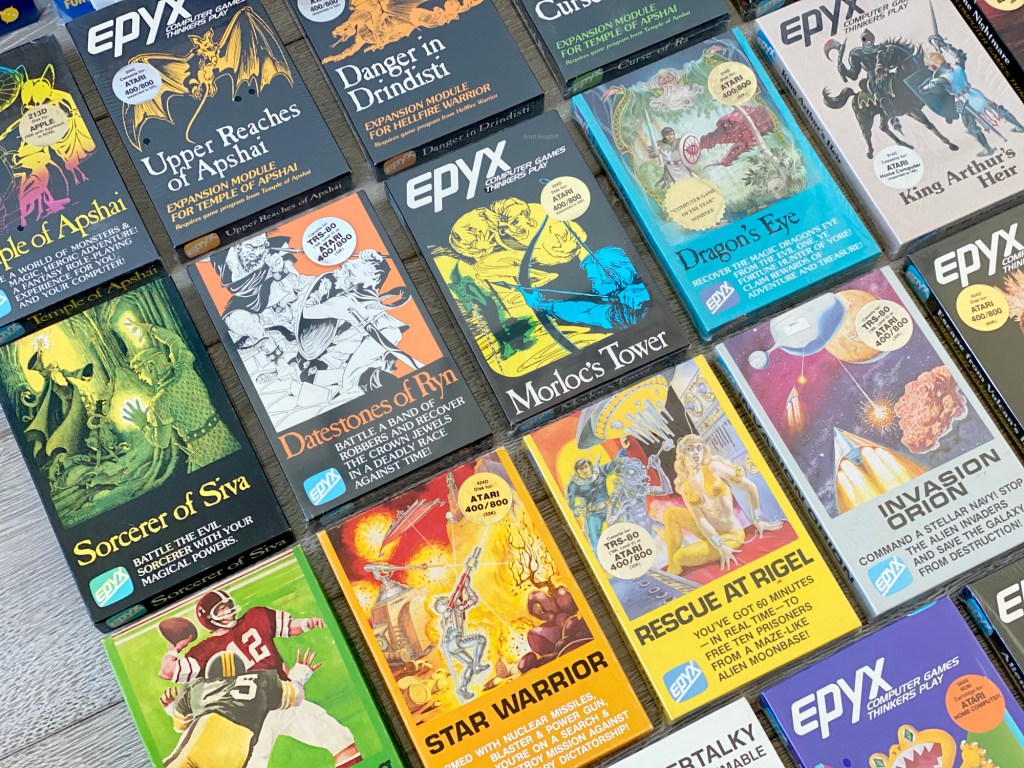
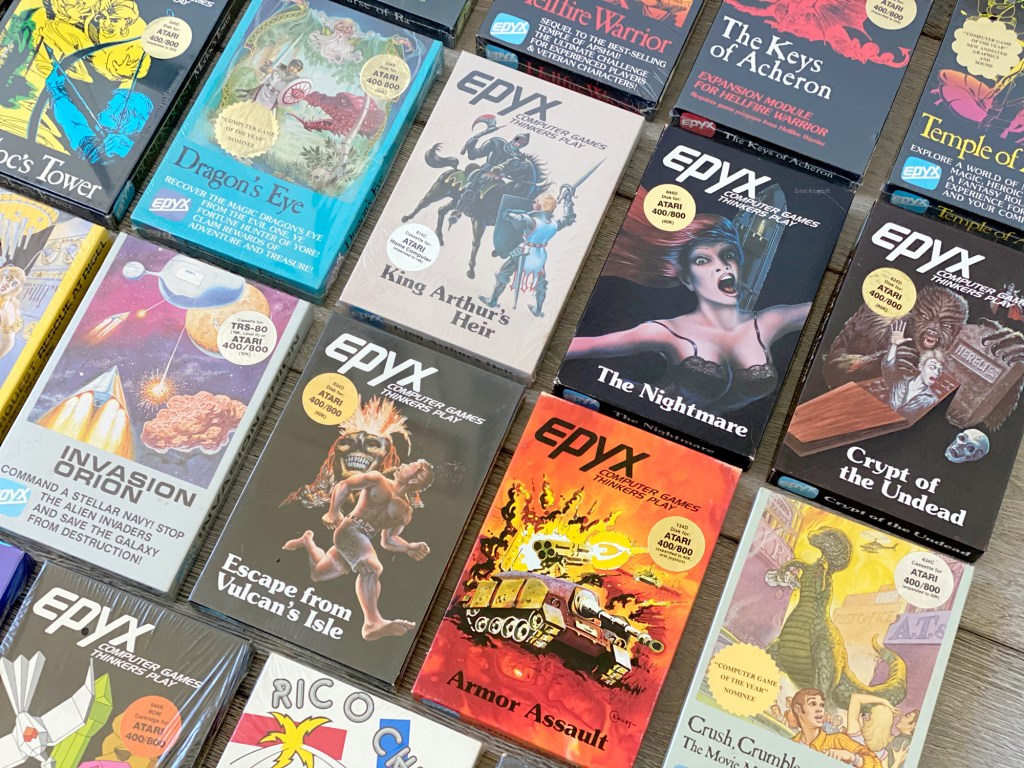
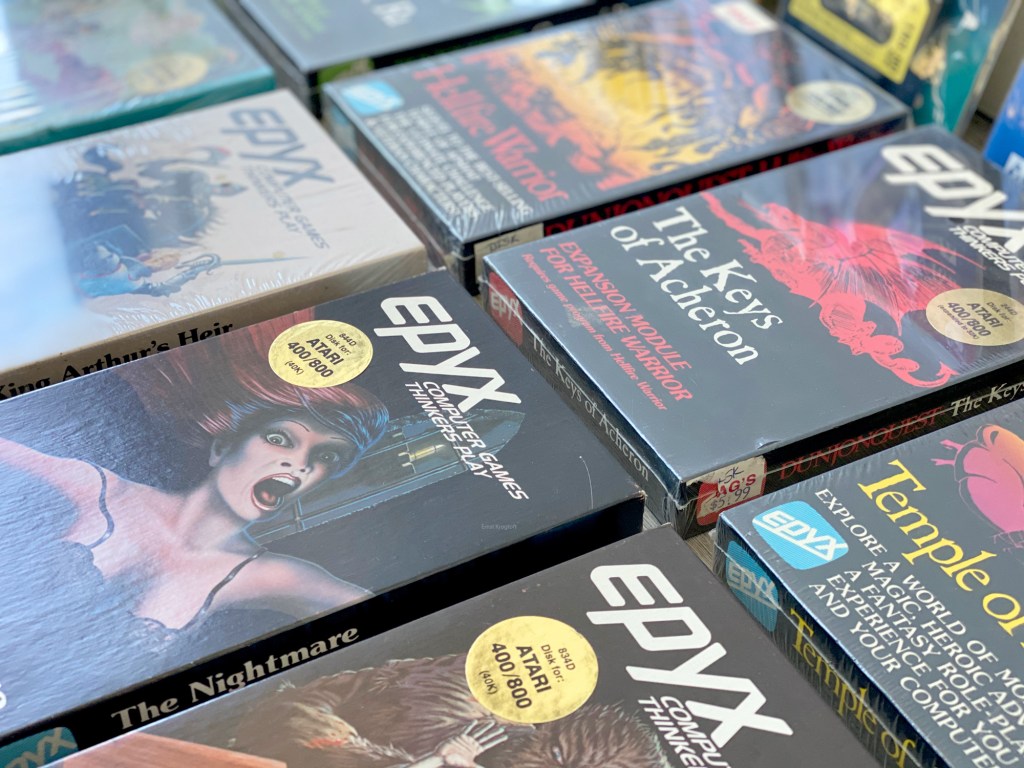
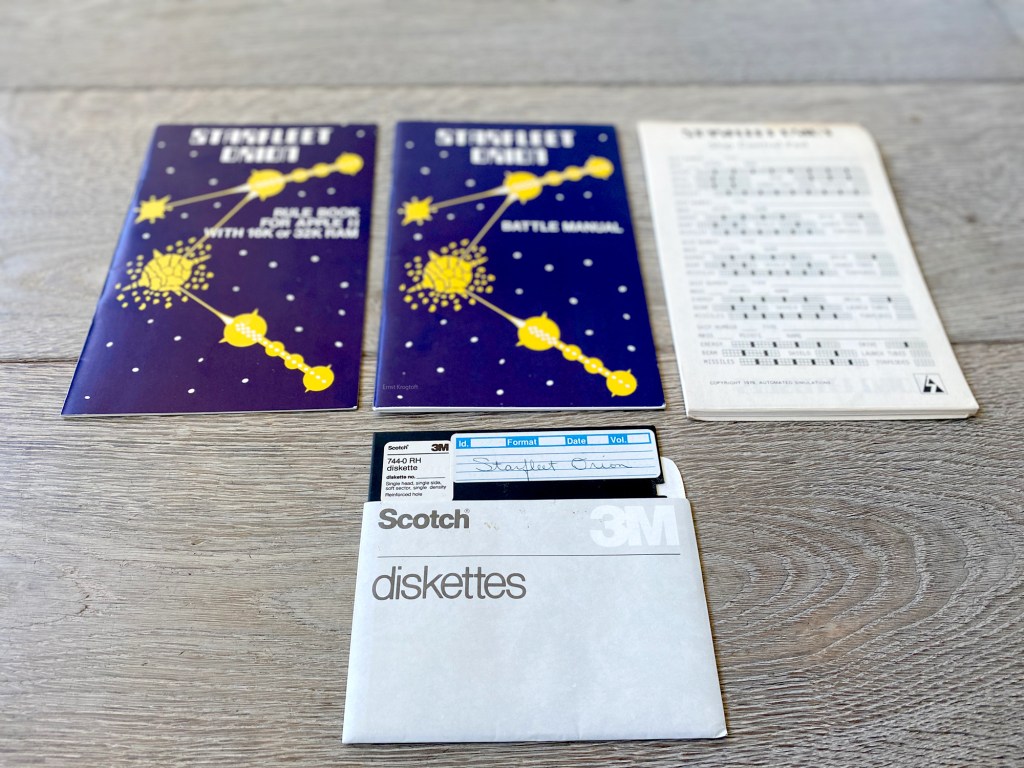
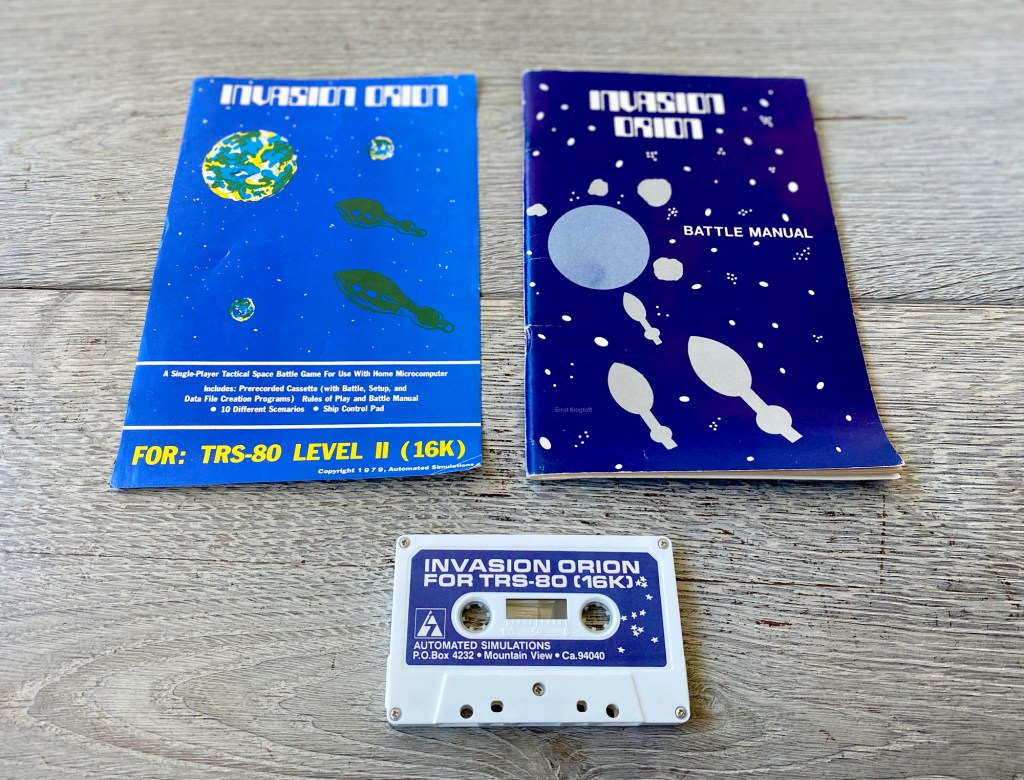
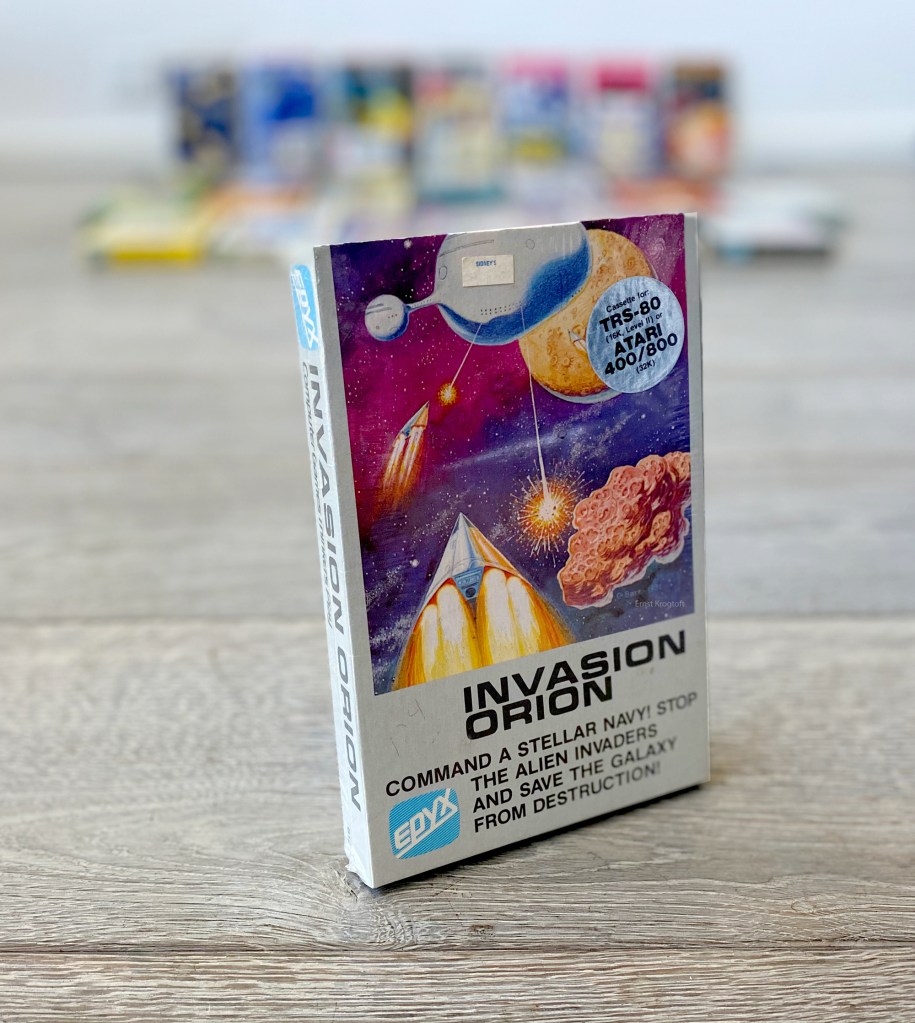
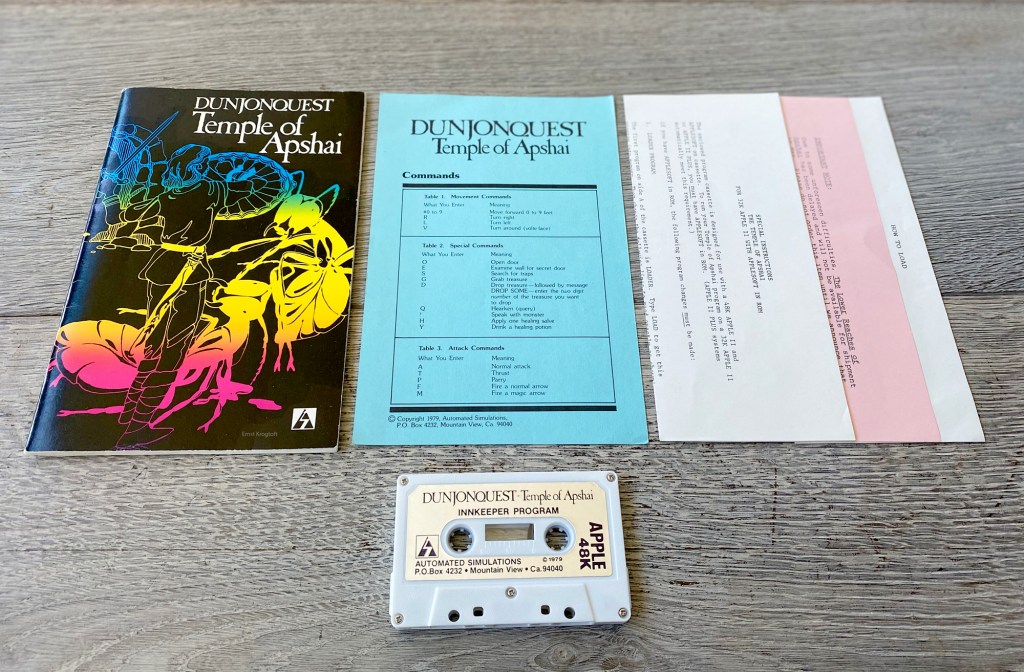
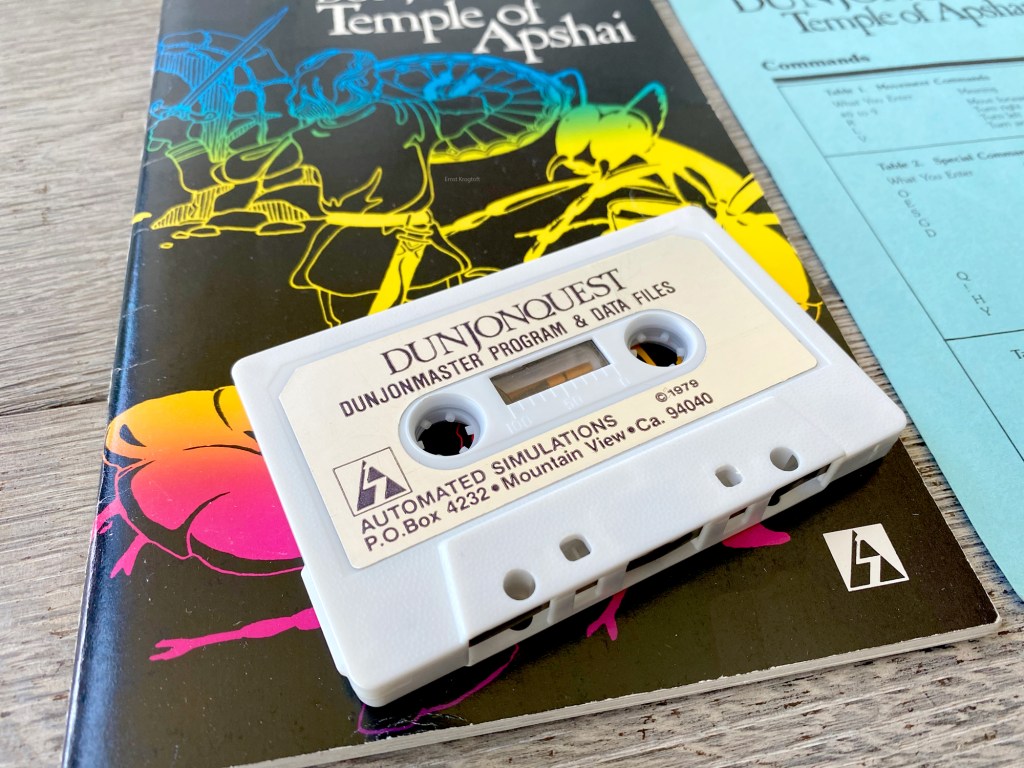
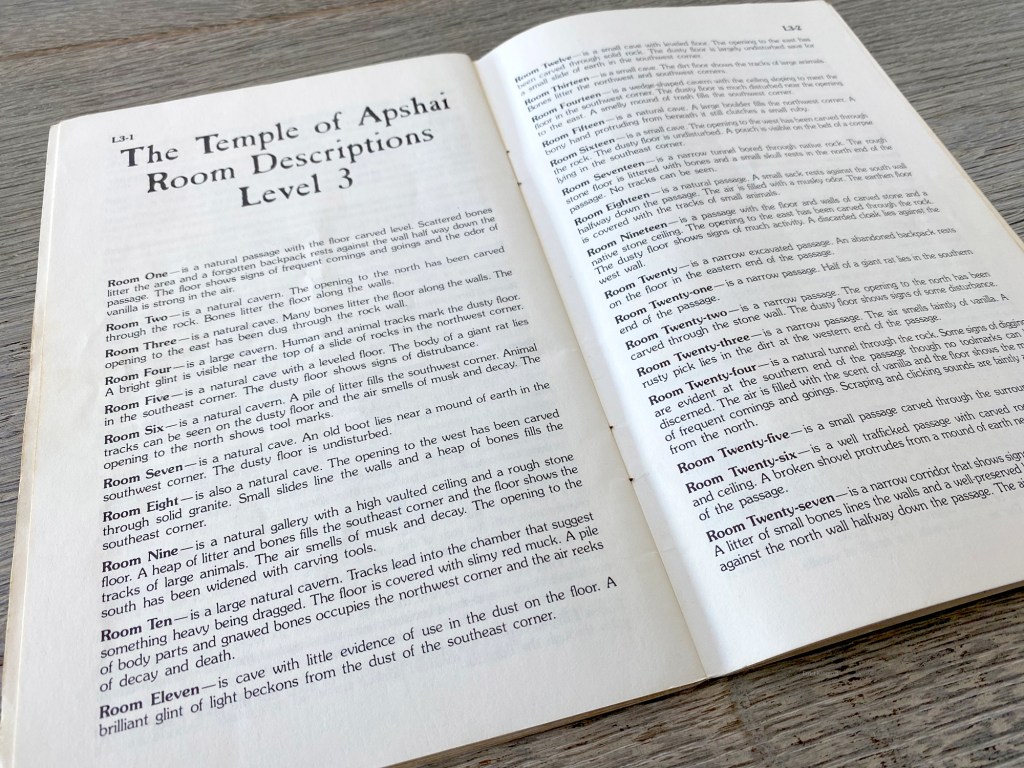
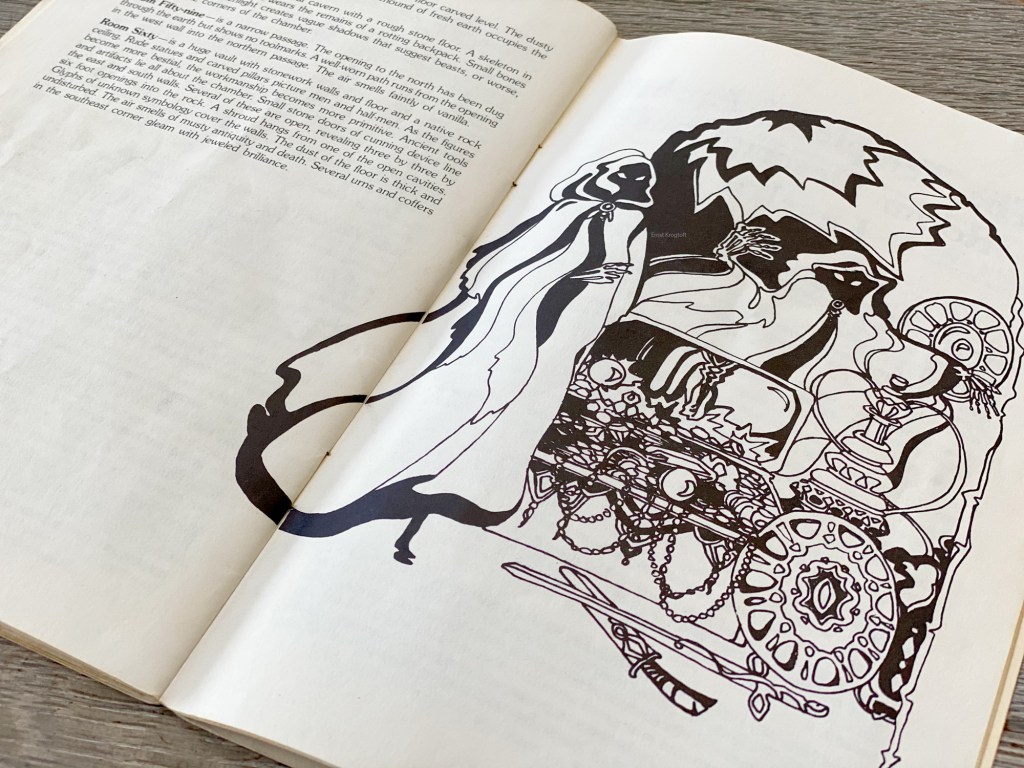
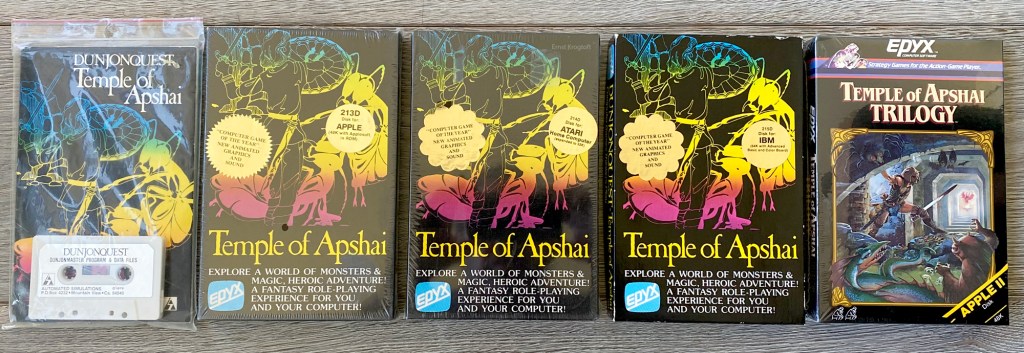
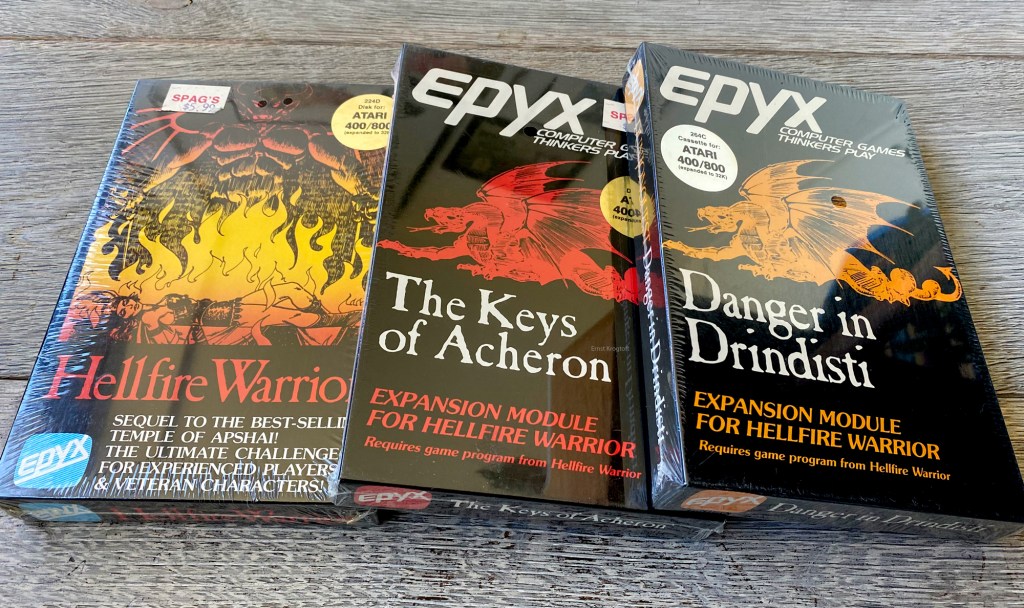
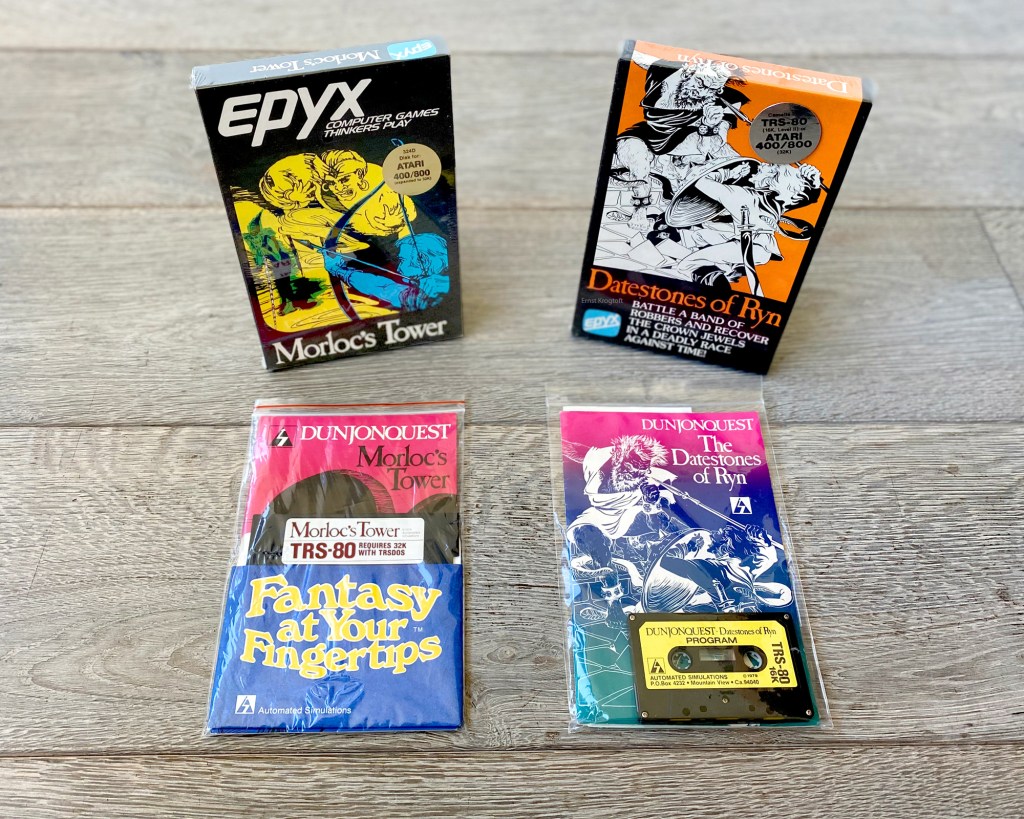

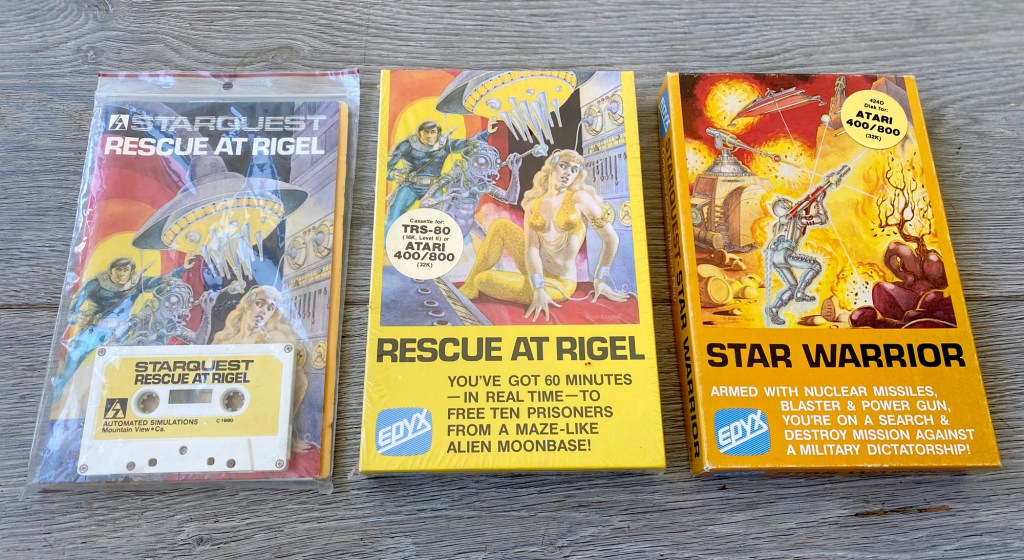
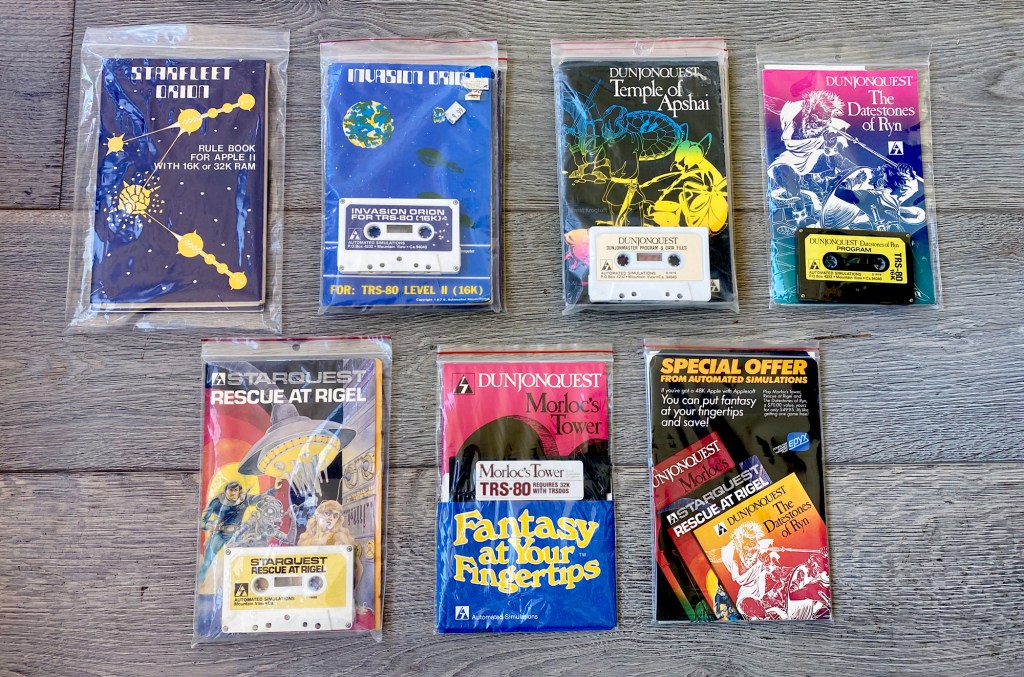
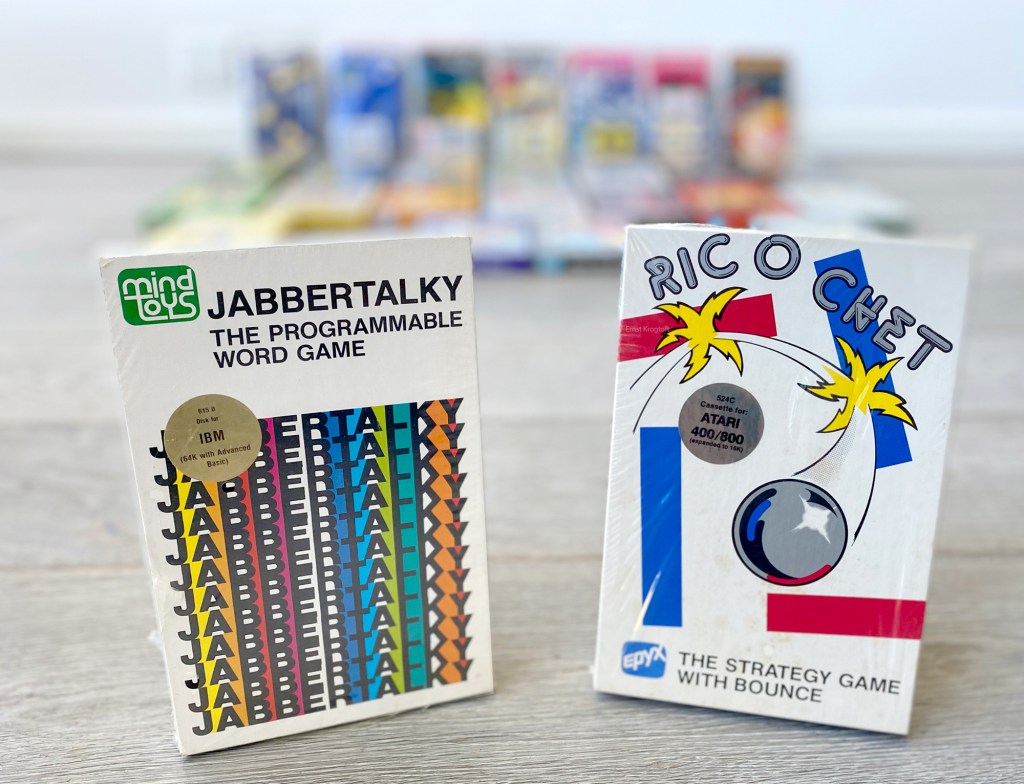
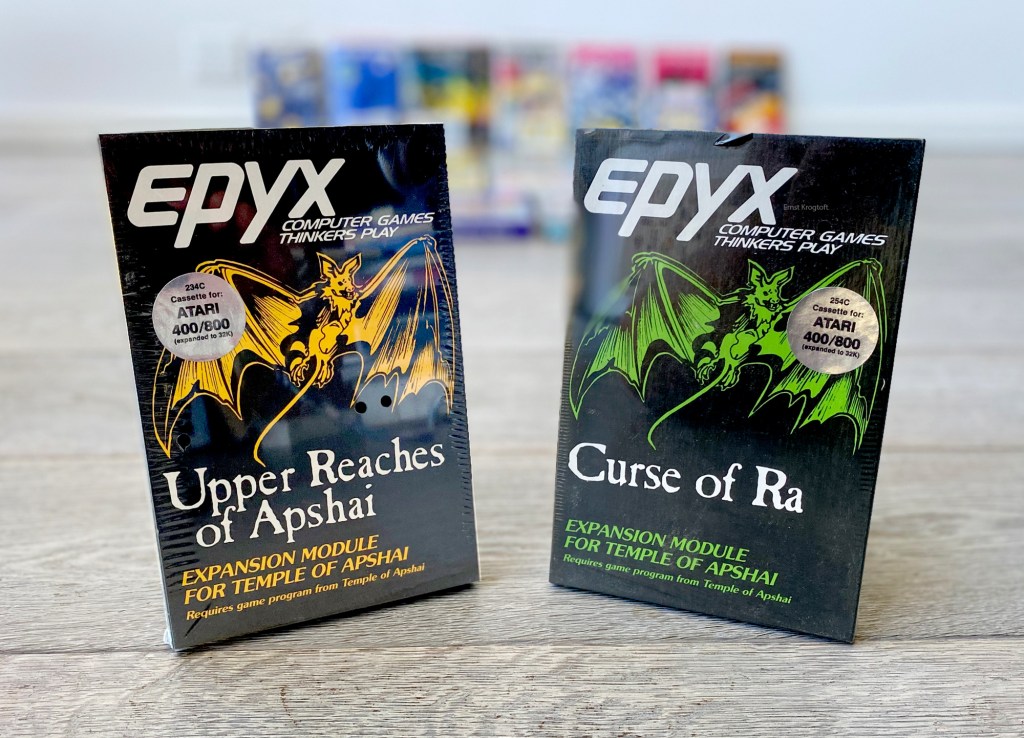


Stunning collection! I bet that looks amazing on a shelf.
I was fortunate enough to bag a copy of Temple of Apshai Trilogy for Atari 8-bit a while back and have been genuinely enjoying playing it with the Book of Apshai by my side — something I never had back in the day!
Thanks, Pete:) It’s something else playing these old games, I also really like how the Book of Lore sets the settings yet still leaves much to one’s imagination.
Another amazing post. I love your collection. This era of games gets the juices flowing just to look at and I always find something to look deeper into. Also you forget the Manor in Beneath Apple Manor, or is there some other weird game where you go into an Apple II and discover how DOS works maybe? Or was it a cool abbreviation like calling The Hitchhiker’s Guide to the Galaxy “Hitchhiker”?
Fantastic articles! I’m doing research on vintage games, as a friend of mine who passed away recently had a massive collection and I’ll be handling them for the estate. One quick question — he had several copies of Starfleet Orion, one of which was 48K for the Apple II (only the disk says 48K, the manuals all say 32K). I’ve not been able to find any info on a 48K version online, and was hoping that you might have some info.
Thanks, Doug. That’s a good question, my research haven’t come up with a 48k Apple II version. To my knowledge, these are the following Apple versions (all requiring Integer Basic in ROM):
Apple II – Cassette 16K
Apple II – Cassette 32K
Apple II – Disk: 32K
It could be a later release (after Invasion Orion was released in 1979) – Is there a date on the floppy?
Please, could you help me? I am looking for a photo or a scan of the cover of “Sorcerer of Siva”. I would be tremendously grateful to you. A photo (even taken from smartphone) would be a gift. Yours is a clean copy whereas all the analogous images on the web don’t fit my needs because they bear the c64 logo. I have been looking for an high resolution photo for a long time but to no avail.
If you may help: matteodicor@gmail.com
Sorcerer of Siva was never released for the C64 (only the TRS-80 and Apple II), so I’m not sure why you say they all bear the C64 logo…
Yes you’re right , i made a mistake whilst writing…it was the TRS 80 logo that i meant.
Ahh I see, that makes sense.
I can definitely take a photo (I only have an iPhone as a camera) and mail it to you.
I would be very grateful.